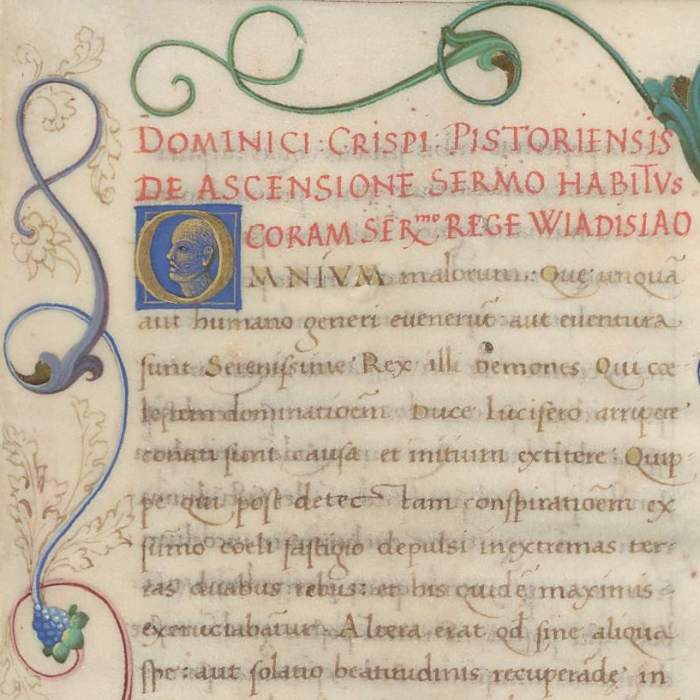Rannusius: Sermo de ascensione
The codex preserves certain aspects of the Hungarian court culture during the reign of Wladislas II of Hungary (1490–1516): the sermon of Rannusius Crispus of Pistoia was delivered in the presence of King Wladislas II, and the codex containing it was made in the court workshop, certainly at the king’s request. The Buda origin of the manuscript can be inferred first of all from the person of the scribe, who played a prominent role in the development of the royal library during the reign of Wladislas’ predecessor, Matthias Corvinus, in the late 1480s. So far, three corvinas and Orbán Nagylucsei’s psalterium can be identified as his work. (See below under ‘scriptor’.) The decoration was probably also made in the royal workshop. It is noteworthy, however, that the style breaks with the Renaissance character of the corvinas and returns to the Gothic style of Central Europe. Only the two initials retain the Renaissance character. We do not yet have a firm basis for dating the codex. Its scribe, who worked under Matthias, however, suggests that the early 1490s are the most likely date. There are other indications that in the early years of his reign, Wladislas II attempted to continue the book culture of his predecessor, and even had ornamental codices made at his court. In the first years, the work of the masters employed at the court of Matthias still appears in the manuscripts of the Wladislas-period, and the style of certain decorations and bindings tries to follow that of the royal codices produced under Matthias. The codex containing the sermon of Nicolaus de Mirabilibus is again a memorial to a religious court event, and like the Rannusius manuscript, it is also the work of royal masters (Vienna, ÖNB, Cod. 1566). (Edina Zsupán)
DATA SHEET
Shelfmark: G. I. 46. – Deissmann 46Country: Turkey
City: Istanbul
Keeper location: Topkapi Serai
Author: Dominicus Crispus Rannusius (15th–16th century)
Content: Sermo de ascensione habitus coram rege Wladislao (Sermon on the Resurrection delivered in the presence of King Wladislas)
Writing medium: parchment
Number of sheets: II + 14 + II*
Sheet size: 198 × 144 mm
Place of writing: Buda
Date of writing: probably the early 1490s
Scriptor: scriptor working for the Buda workshop established under Matthias Corvinus (corvinas in his copy: Budapest, OSZK, Cod. Lat. 417.; Munich, BSB, Clm 175; Venice, BNM, Lat. VIII, 2 [=2796]; he also made a copy of the psalterium of Orbán Nagylucsei: Budapest, OSZK, Cod. Lat. 369.) (Cf. ZSUPÁN Edina, "A Corvina könyvtár budai scriptorai" 2020.)
Place of illumination: Buda
Date of illumination: between 1490 and 1516, probably the early 1490s
Crest: coat-of-arms of Wladislas II (King of Bohemia 1471–1516, King of Hungary 1490–1516)
Possessor, provenience: Wladislas II; the manuscript was taken from Buda to Constantinople by Suleiman I (Sultan of the Ottoman Empire 1520–1566) in 1526
Binding: 19th century Turkish leather binding (the original binding was white leather covered in green silk, cf. CSAPODI, Csaba, The Corvinian Library. History and Stock 1973, 340–341, Nr. 564)
Language of corvina: Latin
